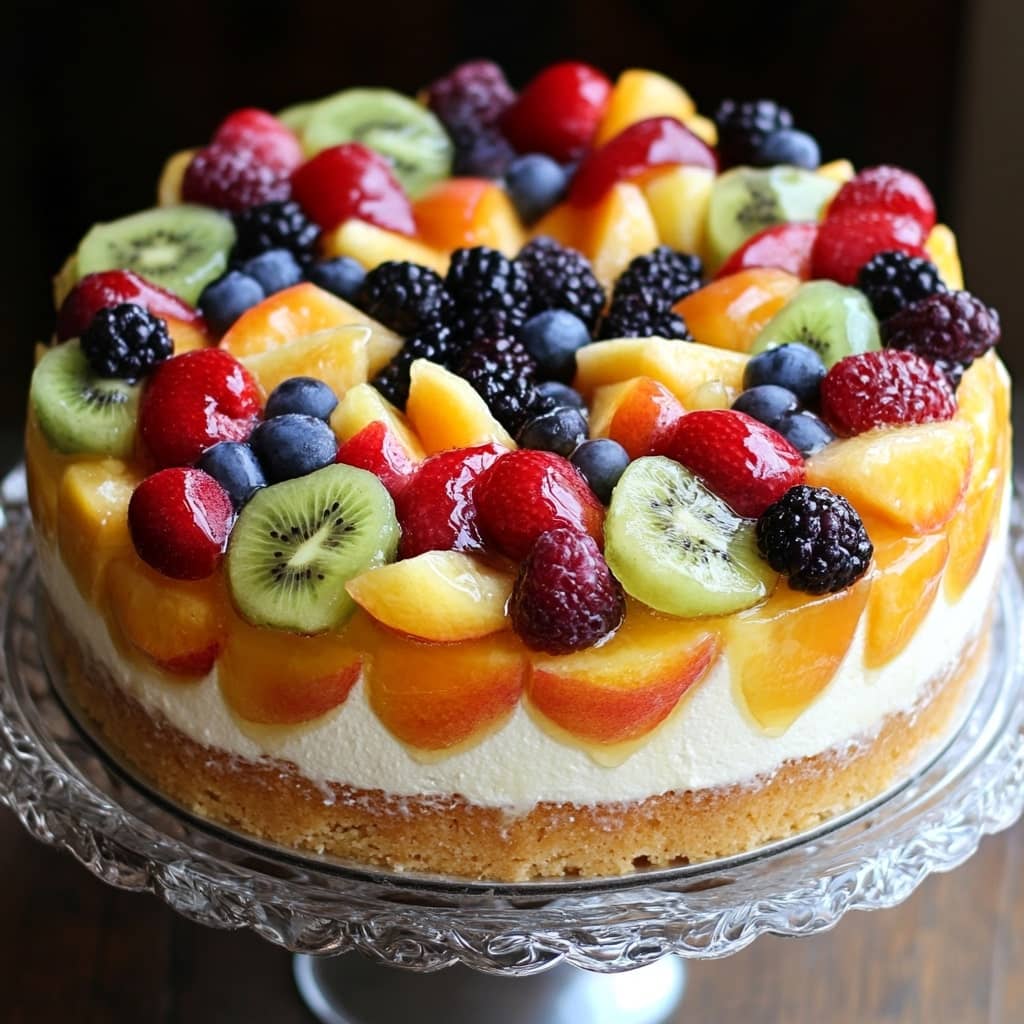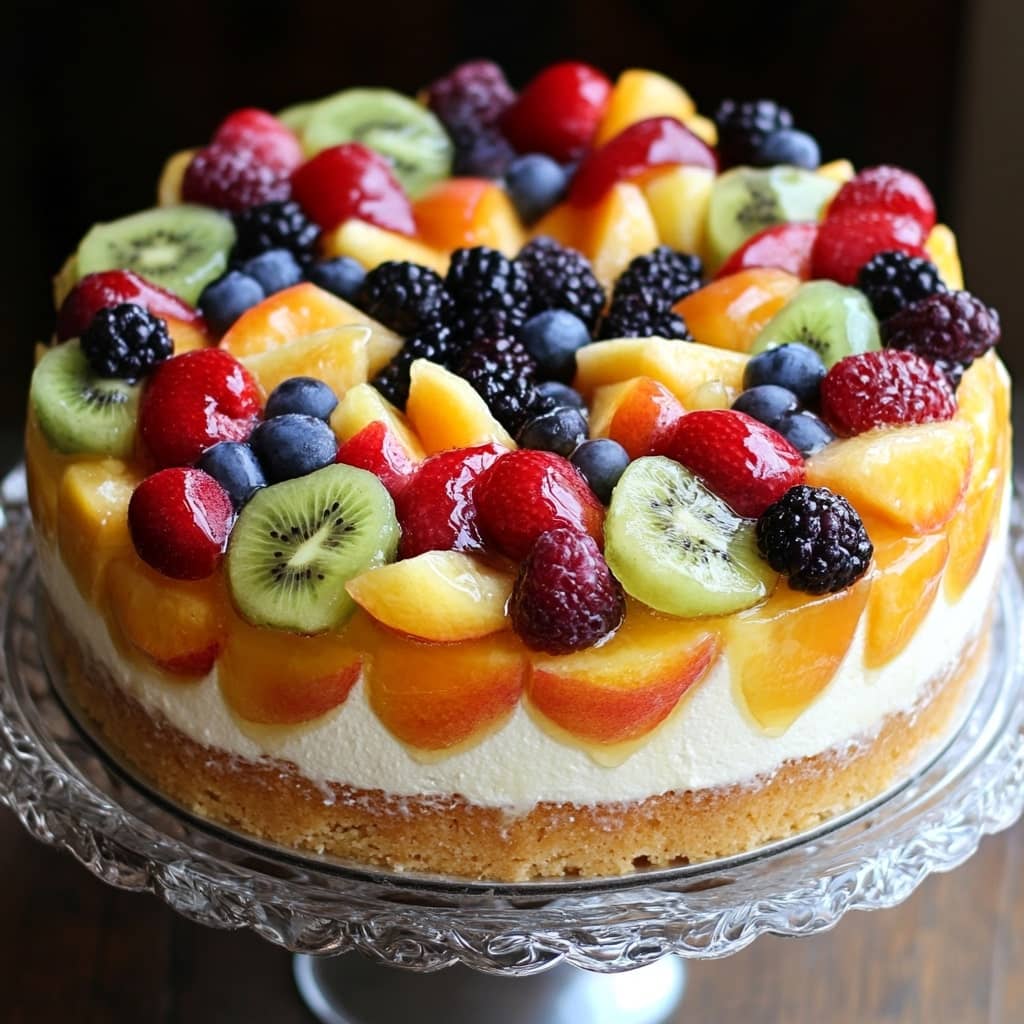A Summer Fruit Sangria Cake is the perfect dessert for warm weather celebrations, bringing together the fresh, juicy vibrancy of summer fruits with the sweet and slightly boozy notes of sangria in cake form. This cake is typically composed of moist, fluffy sponge layers infused with fruit juices or wine, layered or topped with a medley of fresh seasonal fruits such as strawberries, oranges, peaches, and berries, and finished with a light wine syrup or glaze. Sometimes paired with whipped cream, citrusy frosting, or mascarpone, this cake captures the essence of sangria in a playful, elegant dessert. Ideal for garden parties, summer brunches, birthdays, or any warm-weather gathering, this cake looks beautiful, tastes refreshing, and delivers an experience that’s both fun and sophisticated.
The History of Sangria and Fruit Cakes
Sangria has its origins in Spain and Portugal, where it has been enjoyed for centuries as a wine-based punch made with red wine, chopped fruit, and occasionally a splash of brandy or soda. Traditionally served cold, it was created as a way to stretch wine and make it more refreshing during hot months. Over time, sangria evolved with regional variations, often including white wine or sparkling wine for a lighter version, known as “sangria blanca.” On the other hand, fruit cakes have a long history dating back to ancient Rome, where mashed barley was mixed with pomegranate seeds, raisins, and nuts. In modern times, fruit cakes evolved into celebratory desserts, but they were often heavy and dense. The Summer Fruit Sangria Cake is a contemporary twist that combines the elegance of a layered fruit cake with the festive, refreshing qualities of sangria, merging two rich traditions into one vibrant and delightful dessert.
Ingredients Breakdown
For the Cake Layers:
- All-Purpose Flour: Provides the structure and base of the cake.
- Baking Powder & Baking Soda: Help the cake rise and become fluffy.
- Salt: Enhances overall flavor and balances sweetness.
- Unsalted Butter: Adds richness and tenderness to the crumb.
- Granulated Sugar: Sweetens and helps aerate the batter when creamed with butter.
- Eggs: Provide structure and richness, contributing to the cake’s texture.
- Vanilla Extract: Adds warmth and depth to the flavor.
- Orange Juice or White Wine: Used as a nod to sangria; enhances the flavor and moisture.
- Zest of Citrus (Orange, Lemon): Adds fresh, aromatic brightness.
For the Sangria Syrup:
- White or Rosé Wine: The base of the syrup, mimicking sangria’s signature flavor.
- Sugar: Balances acidity and sweetens the syrup.
- Citrus Zest and Juice: Adds zing and reinforces the sangria vibe.
- Fresh Fruit Pieces: Such as oranges, strawberries, or peaches for infusion.
For the Filling and Topping:
- Whipped Cream or Mascarpone Frosting: Adds lightness and creaminess.
- Fresh Summer Fruits: Strawberries, blueberries, raspberries, peaches, cherries, and orange slices.
- Mint Leaves (optional): For garnish and a pop of freshness.
Step-by-Step Recipe
- Preheat your oven to 350°F (175°C). Grease and line two or three 8-inch round cake pans with parchment paper.
- Prepare the dry ingredients: In a medium bowl, whisk together flour, baking powder, baking soda, and salt. Set aside.
- Cream the butter and sugar in a large bowl until light and fluffy. Add the eggs one at a time, beating well after each, then mix in vanilla extract and citrus zest.
- Alternate adding dry ingredients and juice or wine to the butter mixture, starting and ending with the flour mixture. Mix until just combined.
- Divide the batter evenly among the prepared pans and smooth the tops. Bake for 20–25 minutes or until a toothpick inserted in the center comes out clean. Let cakes cool completely on a wire rack.
- Prepare the sangria syrup: In a small saucepan, combine wine, sugar, citrus juice, zest, and fruit. Bring to a simmer and cook until slightly thickened. Strain the syrup and let cool.
- Brush each cake layer generously with the sangria syrup to moisten and flavor the cake.
- Prepare the filling: Whip heavy cream (or mascarpone with a bit of cream) with sugar and a touch of vanilla until medium peaks form.
- Assemble the cake: Place one cake layer on a serving plate, spread with frosting, and top with sliced fresh fruit. Repeat for all layers.
- Top the cake with more whipped frosting and arrange a generous amount of mixed summer fruit decoratively. Drizzle with a little more syrup if desired and garnish with mint.
Tips for the Perfect Summer Fruit Sangria Cake
Use fruits that are ripe but not overly soft—they hold up better when layered and give a cleaner cut. Make sure the sangria syrup is cooled before brushing it on the cake to avoid sogginess. For a more pronounced flavor, allow the syrup to infuse with fruit for a few hours before straining. Chill the assembled cake before serving to help the layers firm up and to make slicing easier. If using mascarpone, do not overwhip as it can split—beat just until smooth. You can make the cake layers and syrup a day ahead and assemble the cake just before serving for best freshness and presentation.
Variations and Customizations
Use rosé or red wine instead of white for a deeper sangria flavor and a slight pink hue. For a non-alcoholic version, use white grape juice or sparkling juice with a splash of lemon juice. Switch out the frosting for cream cheese frosting for a tangy contrast. Infuse the syrup with herbs like basil or mint for an aromatic twist. Add a layer of jam or fruit curd between the layers for extra moisture and flavor. Try adding a thin layer of almond frangipane between cake and frosting for a richer variation. Make it a sheet cake or loaf cake for easier serving at picnics and casual gatherings.
Health Considerations and Nutritional Value
While this cake is filled with fresh fruits, it’s still an indulgent dessert due to the sugar, butter, and alcohol content. A typical slice can range between 350–500 calories depending on the frosting and syrup quantity. You can reduce calories slightly by using a light whipped topping or yogurt-based frosting. For a healthier take, reduce the sugar in the cake and syrup, or skip the syrup altogether and rely on the natural sweetness of the fruit. Gluten-free flour blends can be used for a gluten-free version, and you can opt for dairy-free alternatives in the frosting and cake batter if needed. When using alcohol, be aware that while some evaporates during cooking, not all of it is removed, so keep that in mind when serving to children or those avoiding alcohol.
FAQ
Can I make this cake in advance? Yes! The cake layers and sangria syrup can be prepared a day ahead. Assemble with fresh fruit and frosting shortly before serving for best results.
Can I make this alcohol-free? Absolutely. Use fruit juice or non-alcoholic wine or cider in place of the wine for the syrup.
Can I freeze the cake? The unfrosted cake layers can be frozen for up to a month. Thaw overnight in the fridge before using.
What fruits work best? Berries, peaches, nectarines, cherries, and citrus fruits all work beautifully. Use what’s in season for best flavor.
Will the wine flavor be strong? The syrup adds a subtle flavor—more fruity than boozy. You can adjust the intensity based on how much you use.
Can I use store-bought sangria? Yes, just reduce it slightly with sugar to create a syrup, and make sure the flavors match your chosen fruits.

Summer Fruit Sangria Cake Recipe
Ingredients
Method
- Start by preparing the sponge cake. Preheat your oven to 350°F (175°C) and line two 8-inch round cake pans with parchment paper on the bottom—do not grease the sides of the pans. In the bowl of a stand mixer, add the eggs, granulated sugar, and vanilla extract. Whisk on high speed for 7 to 9 minutes until the mixture becomes thick, pale, and nearly white in color. In a separate bowl, sift together the flour and baking powder. Gradually add the dry ingredients into the egg mixture in small increments, gently folding them in with a spatula each time. Be sure to fold carefully from the bottom to avoid deflating the batter. Divide the batter evenly between the prepared pans and bake in the preheated oven for 19 to 21 minutes, or until the cakes are a rich golden-brown and a toothpick inserted in the center comes out clean. Remove from the oven and run a knife around the edges to loosen the cakes from the pans. Allow the cakes to cool completely in the pans. Once cooled, use a long serrated knife to carefully split each cake in half horizontally, resulting in four even layers.
- Begin by making the berry sauce. In a small saucepan, combine the raspberries and granulated sugar. Use a spoon to mash the berries slightly, then bring the mixture to a simmer over medium-high heat. Cook for 4 to 5 minutes until the berries break down completely. Transfer the mixture to a fine mesh strainer set over a bowl. Press the berry pulp through with the back of a spoon, discarding the seeds and remaining solids. Chill the resulting sauce in the refrigerator until completely cooled. Meanwhile, pour the chilled heavy cream into the bowl of a stand mixer and add the confectioner’s sugar. Whip on medium speed for a few minutes, then increase the speed and continue whipping until stiff peaks form, about 3 to 4 minutes. In a separate bowl, beat the softened cream cheese or mascarpone until smooth and creamy. Add the melted (and slightly warm) white chocolate, vanilla extract, and a pinch of salt. Beat again until fully combined. Add the chilled berry sauce, and if desired, a few drops of red food coloring for a deeper hue. Beat again until the sauce is well incorporated. Gently fold the berry and cheese mixture into the whipped cream, whisking for 15 seconds to 1 minute until light and fluffy. Scrape down the bowl to make sure everything is well combined. Use immediately or refrigerate until needed.
- With a serrated knife, slice each cooled sponge cake layer in half to create a total of four even layers. In a bowl, combine the sliced fruit and berries, mixing gently. Generously soak each sponge layer with the sangria wine using a pastry brush or squeeze bottle. Spread a generous amount of the prepared frosting over each soaked layer, then top with a portion of the mixed fruit, pressing the fruit lightly into the frosting to hold it in place. Stack the layers, continuing the process, then cover the top and sides of the cake with the remaining frosting. If you’d like, tint a portion of the frosting with yellow and pink food coloring to create a soft peach shade for decoration. Pipe decorative swirls or dollops of cream on top and garnish with extra fresh fruit and berries for a vibrant, summery finish. Place the finished cake in the refrigerator and allow it to chill for at least one hour, or overnight, to set fully before serving.
